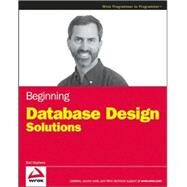Beginning Database Design Solutions
, by Stephens, Rod- ISBN: 9780470385494 | 0470385499
- Cover: Paperback
- Copyright: 11/10/2008
This book is intended for IT professionals and students who want to learn how to design, analyze, and understand databases. The material will benefit those who want a better high-level understanding of databases such as proposal managers, architects, project managers, and even customers. The material will also benefit those who will actually design, build, and work with databases such as database designers, database administrators, and programmers. In many projects, these roles overlap so the same person may be responsible for working on the proposal, managing part of the project, and designing and creating the database.This book is aimed at IT professionals and students of all experience levels. It does not assume that you have any previous experience with databases or programs that use them. It doesnrs"t even assume that you have experience with computers. All you really need is a willingness and desire to learn.This book explains database design. It tells how to plan a databasers"s structure so the database will be robust, resistant to errors, and flexible enough to accommodate a reasonable amount of future change. It explains how to discover database requirements, build data models to study data needs, and refine those models to improve the databasers"s effectiveness.The book solidifies these concepts by working through a detailed example that designs a realistic database. Later chapters explain how to actually build databases using two common database products: Access 2007 and MySQL.The book finishes by describing some of the topics you need to understand to keep a database running effectively such as database maintenance and security.This book explains database design. It tells how to determine what should go in a database and how the database should be structured to give the best results.This book does not focus on actually creating the database. The details of database construction are different for different database tools so, to remain as generally as useful as possible, this book doesnrs"t concentrate on any particular database system. You can apply the techniques described here equally to whatever database tool you use whether itrs"s Access, SQL Server, Oracle, MySQL, or some other database product.Most database products include free editions that you can use for smaller projects. For example, SQL Server Express Edition, Oracle Express Edition, and MySQL Community Server are all free.To remain database neutral, the book does not assume you are using a particular database so you donrs"t need any particular software or hardware. To work through the Exercises, all you really need is a pencil and some paper. You are welcome to type solutions into your computer if you like but you may actually find working with pencil and paper easier than using a graphical design tool to draw pictures, at least until you are comfortable with database design and are ready to pick a computerized design tool."Goals of Effective Database Design," explains the reasons why people and organizations use databases. It explains a databasers"s purpose and conditions that it must satisfy to be useful. This also describes the basic ACID (Atomicity, Consistency, Isolation, Durability) and CRUD (Create, Read, Update, Delete) features that any good database should have. It explains in high-level general terms what makes a good database and what makes a bad database."Database Types," explains some of the different types of databases that you might decide to use. These include flat files, spreadsheets, hierarchical databases (XML), object databases, and relational databases. The relational database is one of the most powerful and most commonly used forms of database so it is the focus of this book, but it is important to realize that there are alternatives that may be more appropriate under certain c







